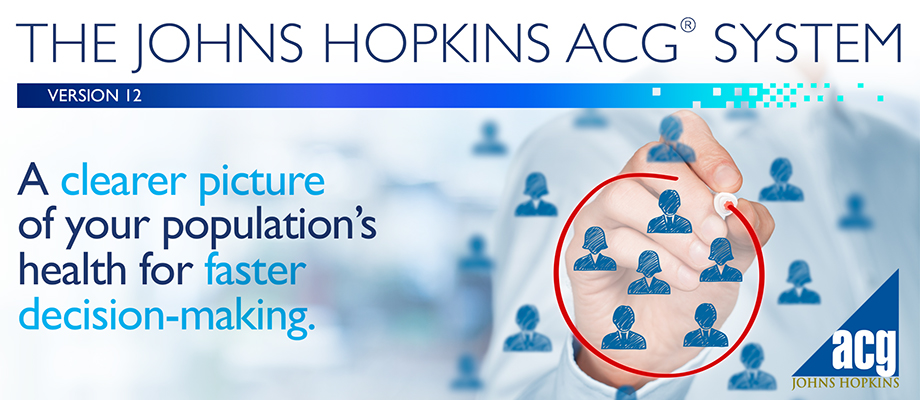
Hundreds of millions of patients worldwide are actively monitored using the Johns Hopkins ACG System. The newest version leverages additional sources of data to better assess and stratify populations.
The Johns Hopkins Bloomberg School of Public Health and Johns Hopkins HealthCare Solutions today announce an updated version of the world-renowned Johns Hopkins ACG® System Population Health Analytics software. The ACG System, in commercial use since 1991, is a comprehensive suite of tools to improve quality of care, better predict resource utilization, reduce costs, and improve efficiency in the health care sector.
Version 12.0 of the ACG System software offers valuable enhancements, which provide an ever-growing and more sophisticated toolkit for managing population health. Some of the most notable updates include:
To classify emergency department visits, Johns Hopkins has updated and expanded the New York University Emergency Department Visit classification algorithm for the ACG System. This methodology categorizes emergency visits into one of eleven categories for summary reporting, outcomes analysis, patient management, and provider profiling. This enables better assessment of the reasons for emergency department visits, which in turn allows organizations to identify and address avoidable use.
Using laboratory values as inputs, the software will allow users to identify patients who have select conditions and the level of control over their condition. One such condition is diabetes, which affects over 422 million people globally, according to the World Health Organization. “Having a better handle on the management of diabetes will be instrumental in offering chronic care management interventions to the right people at the right time,” says Jonathan Weiner, Dr.PH., Scientific Director of the ACG System team and professor with the Bloomberg School’s Department of Health Policy and Management. “The additional lab markers will further refine risk assessment and support improvements in quality of care, which continues to be our primary goal with the ACG System.”
Using pharmacy fill information and diagnosis coding, the ACG System’s opioid use/misuse measures will provide a means to examine the cost and utilization relationships for patients who are at high-risk of opioid use. “There has been little research on the association between the extent of an individual’s high-risk use of opioids and their health care utilization,” says Hsien-Yen Chang, Ph.D., M.S., M.H.S., Associate Scientist at the Bloomberg School. “We created metrics that capture the high-risk prescription opioid use first, then showed that these metrics were associated with prospective health care costs and utilization. This will be invaluable to the health care industry as together we continue to improve the available methods of identifying, treating, and preventing opioid misuse.”
A new marker will indicate a “newly-diagnosed” condition by using additional historical information as the basis for supplemental or previously diagnosed chronic conditions. This allows for improved allocation of scarce care management resources and better sorting of those patients needing educational information from those for whom more intensive coordination might be appropriate. “Chronic conditions put patients and populations at increased risk, and appropriate tracking of chronic conditions is an important part of understanding and predicting health care need. Keeping track of individuals with chronic conditions, as well as those who are newly diagnosed, is a vital part of population health management,” explains Kumar Subramaniam, M.B.A, Executive Director of Population Health Analytics at Johns Hopkins HealthCare Solutions.
In response to changes in practice patterns and requests from our user base, version 12.0 of the ACG System also offers many new improvements. The Expanded Diagnosis Clusters (EDCs) now include specific categories for Hepatitis C and Post-Traumatic Stress Disorder (PTSD). Similarly, Rx-MG assignments have been updated and enhanced to capture advances in therapeutics and to add precision to drug assignments. Originally comprised of 67 categories, the new Rx-MG schema includes 84 Rx-MG assignments representing 20 organ systems or symptom groupings. Version 12.0 also includes a new frailty concept count, automatic calculation of additional utilization markers and numerous technical enhancements.
“With these new features and functionality, we continue our commitment to address the evolving needs of payers, providers and other users of population health management programs, to better understand and stratify their patient groups,” recaps Mr. Subramaniam.
—————
Resources for current ACG System Users (requires authentication):
For updates on this and other Johns Hopkins Population Health Analytics information, sign up for our e-newsletter.